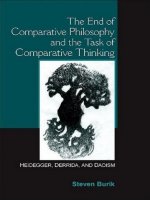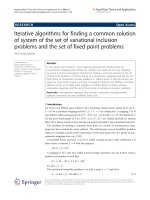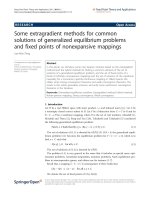Modeling and heuristic solutions of university timetabling problems
Bạn đang xem bản rút gọn của tài liệu. Xem và tải ngay bản đầy đủ của tài liệu tại đây (2.57 MB, 240 trang )
MODELING AND HEURISTIC SOLUTIONS OF
UNIVERSITY TIMETABLING PROBLEMS
ALDY GUNAWAN
NATIONAL UNIVERSITY OF SINGAPORE
2008
MODELING AND HEURISTIC SOLUTIONS OF
UNIVERSITY TIMETABLING PROBLEMS
ALDY GUNAWAN
(B.Eng (Ubaya), M.Sc, M. Eng (NUS))
A THESIS SUBMITTED
FOR THE DEGREE OF DOCTOR OF PHILOSOPHY
DEPARTMENT OF INDUSTRIAL AND SYSTEMS ENGINEERING
NATIONAL UNIVERSITY OF SINGAPORE
2008
i
ACKNOWLEDGEMENTS
I would like to express my sincere gratitude to my supervisors, Dr Ng Kien Ming and
Associate Professor Poh Kim Leng, not only for their invaluable guidance and useful
suggestions throughout the study and research process, but also for their care and assistance
during the whole period.
My special gratitude is expressed to my beloved wife, Novianty Tandian, my daughter,
Natasha Alexandra Gunawan as well as my family for their special support during my study. I
would like to thank to all other lecturers and staff members of the Industrial and Systems
Engineering Department, National University of Singapore, for the continuous support, and
necessary facilities which are very important in carrying out this research.
I also wish to extend my appreciation to my colleagues and friends in the Computing Lab (ISE
department) who have helped me and made my life in NUS enjoyable and fruitful.
Aldy Gunawan
December 2008
ii
GLOSSARY
3-SAT 3-Satisfiability
COP Combinatorial Optimization Problem
CS Course Scheduling
EP Examination Problem
GRASP Greedy Randomized Adaptive Search Procedure
GRASP-SA-TS Greedy Randomized Adaptive Search Procedure - Simulated Annealing -
Tabu Search
LR Lagrangian Relaxation
LR-SA Lagrangian Relaxation - Simulated Annealing
QAP Quadratic Assignment Problem
QAPLIB Quadratic Assignment Problem Library
QSAP Quadratic Semi-Assignment Problem
RTT Restricted Timetable Problem
SA Simulated Annealing
SA1 Simulated Annealing 1
SA2 Simulated Annealing 2
SA-TS Simulated Annealing - Tabu Search
TA Teacher Assignment
TACS Teacher Assignment - Course Scheduling
TS Tabu Search
iii
TABLE OF CONTENTS
Acknowledgements i
Glossary ii
Table of Contents iii
Summary viii
List of Tables xi
List of Figures xiv
Nomenclature xvi
Chapter I Introduction 1
1.1 Background and Motivation 4
1.2 Scope of the Study 6
1.3 Purpose of the Study 7
1.4 Organization of the Thesis 8
Chapter II Literature Review 10
2.1 Introduction 10
2.2 The Classification of the Timetabling Problem 11
2.2.1 The Course Timetabling Problem 11
2.2.2 The Examination Timetabling Problem 17
2.3 Formulation of the Timetabling Problem 18
2.4 Algorithms for the Timetabling Problem 21
2.4.1 Algorithms for the Course Timetabling Problem 21
2.4.1.1 Global Algorithms 21
2.4.1.2 Constructive Heuristics 24
2.4.1.3 Improvement Heuristics 25
2.4.1.4 Interactive Systems 29
2.4.2 Algorithms for the Examination Timetabling Problem 29
iv
2.4.2.1 Cluster Methods 30
2.4.2.2 Sequential Methods 30
2.4.2.3 Generalized Search Strategies (Improvement Heuristics) 31
2.4.2.4 Constraint Based Approaches 32
2.5 Overview of Hybrid Algorithms 32
2.5.1 Hybridization of Heuristics 34
2.5.2 Hybridization of Exact Algorithms and Heuristics/Metaheuristics 36
Chapter III Mathematical Programming Models for the Course Timetabling
Problem 38
3.1 Introduction 38
3.2 The Basic TACS problem 39
3.2.1 Problem Description 39
3.2.2 The Mathematical Programming Model 40
3.2.3 Computational Results 42
3.3 The First Extended TACS problem 49
3.3.1 Problem Description 49
3.3.2 The Mathematical Programming Model 50
3.3.3 Computational Results 53
3.4 The Second Extended TACS problem 57
3.4.1 Problem Description 57
3.4.2 The Mathematical Programming Model 59
3.4.3 Computational Results 66
3.5 Conclusions 71
Chapter IV An Improvement Heuristic for the TACS Problem 73
4.1 Introduction 73
4.2 The Proposed Heuristic 73
4.2.1 The Pre-Processing Phase 74
4.2.2 The Construction Phase 75
v
4.2.3 The Improvement Phase 82
4.3 Computational Results 84
4.4 Conclusions 89
Chapter V Hybridization of Heuristics for the TACS Problem 91
5.1 Introduction 91
5.2 Hybridization of Heuristics 92
5.2.1 The Pre-Processing Phase 93
5.2.2 The Construction Phase 93
5.2.3 The Improvement Phase 96
5.2.3.1 Algorithm SA1 98
5.2.3.2 Algorithm SA2 101
5.2.3.3 Algorithm SA-TS 103
5.3 Computational Results 106
5.4 Conclusions 114
Chapter VI Hybridization of Lagrangian Relaxation and Metaheuristics for the
TACS Problem 116
6.1 Introduction 116
6.2 The Proposed Algorithm 117
6.2.1 The Pre-Processing Phase 117
6.2.2 The Construction Phase 117
6.2.2.1 The Teacher Assignment Sub-Problem 119
6.2.2.2 The Course Scheduling Sub-Problem 119
6.2.2.3 The Subgradient Search Method 122
6.2.2.4 A Lagrangian Heuristic 123
6.2.3 The Improvement Phase 129
6.3 Computational Results 129
6.4 Conclusions 135
vi
Chapter VII Hybridization of Metaheuristics for the Examination Timetabling
Problem 137
7.1 Introduction 137
7.2 The Quadratic Assignment Problem (QAP) 139
7.2.1 The Mathematical Programming Model 144
7.2.2 The Proposed Algorithm 146
7.2.2.1 The Construction Phase 146
7.2.2.2 The Improvement Phase 149
7.2.3 Computational Results 151
7.3 The Extended Examination Timetabling Problem 157
7.3.1 The Mathematical Programming Model 158
7.3.2 The Lower Bound 161
7.3.3 The Proposed Algorithm 163
7.3.3.1 The Construction Phase 163
7.3.3.2 The Improvement Phase 166
7.3.4 Computational Results 167
7.4 Conclusions 171
Chapter VIII Conclusions and Future Research Work 172
8.1 Major Findings and Contributions 172
8.2 Limitations and Future Research Work 177
References 180
Publications 203
Appendix A Procedures of the Improvement Heuristic 205
Appendix B1 Flow Chart of the Construction Phase 208
Appendix B2 Flow Chart of Algorithm SA1 209
Appendix B3 Flow Chart of the Evaluation Process of Algorithms SA1 and SA2 210
Appendix B4 Flow Chart of Algorithm SA2 211
Appendix B5 Flow Chart of Algorithm SA-TS 212
vii
Appendix B6 Flow Chart of the Evaluation Process of Algorithm SA-TS 213
Appendix C1 Flow Chart of the First Process of a Lagrangian Heuristic 214
Appendix C2 Flow Chart of the Second Process of a Lagrangian Heuristic 215
Appendix C3 Flow Chart of Algorithm LR-SA 216
Appendix D1 Flow Chart of the Construction Phase of GRASP Algorithm 217
Appendix D2 Flow Chart of Algorithm SA-TS for the Basic Examination
Timetabling Problem 218
Appendix D3 Flow Chart of the Construction Phase of Modified GRASP Algorithm 219
Appendix D4 Flow Chart of Algorithm SA-TS for the Extended Examination
Timetabling Problem 220
Appendix E Solution Representation 221
viii
SUMMARY
Timetabling is the allocation, subject to constraints, of given resources to objects being places
in space time, in such a way as to satisfy as nearly as possible a set of desirable objectives.
Timetabling problems arise in a wide variety of domains including education, sport, transport
and healthcare institutions.
This research mainly focuses on two categories of the educational timetabling problem at the
university level: the course and the examination timetabling problems. There are several
differences between both problems. In the examination timetabling problem, a number of
examinations can often be scheduled into one room or an examination may be split across
several classrooms, where else in the course timetabling problem, it is most typically the case
that one course has to be scheduled into exactly one classroom.
The course timetabling problem can be further decomposed into five different sub-problems:
teacher assignment, class-teacher timetabling, course scheduling, student scheduling and
classroom assignment. In this research, we focus on two sub-problems: teacher assignment and
course scheduling problems. Most research works in this area only focus on one of the sub-
problems of the course timetabling problem, such as the course scheduling problem where it is
often assumed that the teacher assignment problem has already been solved earlier before the
actual scheduling of courses to time periods.
Motivated by the need to overcome this limitation of only considering one sub-problem, three
different mathematical programming models that combine both teacher assignment and course
scheduling problems simultaneously are introduced. This combination is known as the Teacher
Assignment - Course Scheduling (TACS) problem. The first mathematical model, TACS
Model I, is considered as a basic model which accommodates some common requirements.
ix
This model is further extended to two different models, namely, TACS Model II and TACS
Model III, by accommodating some additional requirements.
Initially, we solve these mathematical programming models by using ILOG OPL Studio
software. However, this software could not provide optimal solutions especially for large scale
instances of TACS Model III. A simple improvement heuristic is proposed in order to obtain
the solutions. Since the results obtained by a simple improvement heuristic are not good
enough, four algorithms based on hybridization of the Simulated Annealing and other methods
are proposed to solve the problem. These algorithms are known as Algorithms SA1, SA2, SA-
TS and LR-SA. We conclude that LR-SA outperforms other algorithms in terms of solution
quality.
This research focuses not only on the course timetabling problem, but also on the examination
timetabling problem. In the examination timetabling problem context, majority of the methods
proposed were centered on the general concepts of graph theory. However, some constraints,
such as students cannot take two examinations consecutively, limit the use of graph theory
approach. We formulate the basic examination timetabling problem as a Quadratic Assignment
Problem in order to overcome this limitation.
Algorithm GRASP-SA-TS is proposed in order to solve the problem. This hybrid algorithm is
based on a combination of Greedy Randomized Adaptive Search Procedure, Simulated
Annealing and Tabu Search. The proposed algorithm is able to obtain the optimal or the best
known solutions for several QAP benchmark problems.
In real-world situations, the number of examinations can be greater than the number of time
periods. There should be a possibility to assign more than one examination to a time period.
Therefore, the basic examination timetabling problem is extended to a more general model.
One of the constraints in QAP is relaxed and the entire model is formulated as a Quadratic
x
Semi-Assignment Problem (QSAP). Algorithm GRASP-SA-TS is modified in order to solve
the extended examination timetabling problem. The computational results show the ability of
the hybrid algorithm to provide good quality solutions compared with those of pure SA.
In summary, this study focuses on the course timetabling and examination timetabling
problems. In the course timetabling problems, teacher assignment and course scheduling
problems sub-problems are studied simultaneously which is not commonly studied by other
researchers. Several algorithms based on hybridization of the Simulated Annealing and others
methods are proposed to solve the problem. The idea of the hybrid algorithms is also applied to
the examination timetabling problems that have been formulated as a QAP and QSAP in this
thesis. A hybrid algorithm based on a combination of GRASP, Simulated Annealing and Tabu
Search is introduced to solve the problem.
xi
LIST OF TABLES
Table 2.1 Differences between course and examination timetabling problems 11
Table 2.2 Differences between school and university course timetabling problems 12
Table 2.3 Primary constraints in the timetabling problem 19
Table 2.4 Ordering strategies in the examination timetabling problem 31
Table 2.5 Several applications of metaheuristics to the examination timetabling problem 32
Table 3.1 Characteristics of data sets (TACS Model I) 43
Table 3.2 Computational results by OPL Solver when number of teachers is 50 45
Table 3.3 Computational results by OPL Solver when number of teachers is 100 47
Table 3.4 Distribution of average number of courses taught by each teacher 49
Table 3.5 Characteristics of data sets (TACS Model II) 54
Table 3.6 Computational results by OPL Solver when number of teachers is 25 54
Table 3.7 Computational results by OPL Solver when number of teachers is 50 55
Table 3.8 Computational results by OPL Solver when number of teachers is 75 55
Table 3.9 Distribution of average number of courses taught by each teacher 56
Table 3.10 Number of teachers allocated to a particular course 57
Table 3.11 Characteristics of Group I data sets 67
Table 3.12 Characteristics of Group II data sets 67
Table 3.13 Minimum and maximum number of teachers for each course 67
Table 3.14 Computational results of Group I data sets by OPL Solver 69
Table 3.15 Computational results of Group II data sets by OPL Solver 70
Table 4.1 Parameter settings for the improvement heuristic 84
Table 4.2 Comparison of the heuristic results and the optimal solutions on Group I
data sets 85
Table 4.3 Comparison of the heuristic results and the optimal solutions on Group II
data sets 86
Table 4.4 Distribution of teachers based on the number of courses taught 88
Table 5.1 Terminology relationship 97
xii
Table 5.2 Parameter settings for hybrid algorithms 106
Table 5.3 Computational results of Algorithms SA1, SA2 AND SA-TS on Group I
data sets 108
Table 5.4 Computational results of Algorithms SA1, SA2 AND SA-TS on Group II
data sets 110
Table 5.5 Comparison of the algorithm results and the optimal solutions on Group I
data sets 112
Table 5.6 Comparison of the algorithm results and the optimal solutions on Group II
data sets 113
Table 6.1 Parameter settings for Algorithm LR-SA 130
Table 6.2 Computational results of Algorithm LR-SA on Group I data sets 131
Table 6.3 Computational results of Algorithm LR-SA on Group II data sets 132
Table 6.4 Comparison of the algorithm results and the optimal solutions on Group I
data sets 133
Table 6.5 Comparison of the algorithm results and the optimal solutions on Group II
data sets 134
Table 7.1 Several applications of the Quadratic Assignment Problem 140
Table 7.2 Some applications of heuristics to the Quadratic Assignment Problem 143
Table 7.3 Parameter settings for Algorithm SA-TS (the basic examination timetabling
problem) 152
Table 7.4 Computational results of Algorithm SA-TS on problem class chr 153
Table 7.5 Computational results of Algorithm SA-TS on problem class had 154
Table 7.6 Computational results of Algorithm SA-TS on problem class kra 154
Table 7.7 Computational results of Algorithm SA-TS on problem class nug 154
Table 7.8 Computational results of Algorithm SA-TS on problem class rou 155
Table 7.9 Computational results of Algorithm SA-TS on problem class scr 155
Table 7.10 Computational results of Algorithm SA-TS on problem class sko 156
Table 7.11 Computational results of Algorithm SA-TS on problem class tai 156
Table 7.12 Computational results of Algorithm SA-TS on problem class wil 156
xiii
Table 7.13 Characteristics of the extended examination timetabling problem data sets 168
Table 7.14 Parameter settings for Algorithm SA-TS (the extended examination timetabling
problem) 169
Table 7.15 Computational results of Algorithm SA-TS 169
Table 7.16 Comparison of the algorithm results and the lower bounds 170
xiv
LIST OF FIGURES
Figure 1.1 Classification of educational timetabling problems 7
Figure 2.1 University course timetabling problem 13
Figure 2.2 A numerical example for the course scheduling problem 14
Figure 2.3 A numerical example for the course timetabling problem 14
Figure 2.4 Major classification of exact/metaheuristic combinations 36
Figure 3.1 Time periods in a week 43
Figure 3.2 Part of the result of data set 50_1(1) 46
Figure 3.3 Plot of average CPU time for data sets 50_1, 50_6 to 50_9 46
Figure 3.4 Plot of average CPU time for data sets 100_1, 100_6 to 100_9 48
Figure 3.5 TACS Model III 58
Figure 4.1 Improvement heuristic 74
Figure 4.2 A numerical example to illustrate the construction phase 77
Figure 4.3 Two possible moves 82
Figure 5.1 Pseudocode of the construction phase 95
Figure 5.2 Part of the initial solution of data set 5×5_1(1) 96
Figure 5.3 Solution representation of Algorithm SA1 99
Figure 5.4 Pseudocode of Algorithm SA1 100
Figure 5.5 Evaluation process of Algorithms SA1 and SA2 100
Figure 5.6 Pseudocode of Algorithm SA2 101
Figure 5.7 Solution representation of Algorithm SA2 102
Figure 5.8 Pseudocode of Algorithm SA-TS 105
Figure 5.9 Evaluation process of Algorithm SA-TS 105
Figure 6.1 Framework of the construction phase 122
Figure 6.2 First process of a Lagrangian heuristic 125
Figure 6.3 Second process of a Lagrangian heuristic 128
Figure 7.1 An example of examination timetabling problem as an undirected weighted
Graph 138
xv
Figure 7.2 Construction phase of GRASP Algorithm 147
Figure 7.3 A numerical example for illustrating GRASP algorithm 148
Figure 7.4 A numerical example of the costs of interaction in GRASP algorithm 148
Figure 7.5 A numerical example of C
tv
in GRASP algorithm 149
Figure. 7.6 Algorithm SA-TS for the basic examination timetabling problem 151
Figure 7.7 Construction phase of Modified GRASP algorithm 164
Figure 7.8 A numerical example for illustrating modified GRASP algorithm 164
Figure 7.9 A numerical example of the costs of interaction in modified GRASP algorithm 165
Figure 7.10 A numerical example of C
tv
in modified GRASP algorithm 165
Figure 7.11 Algorithm SA-TS for the extended examination timetabling problem 166
Figure 8.1 Framework of the study 172
xvi
NOMENCLATURE
The following nomenclatures will be used throughout the thesis:
i Index of teacher
j Index of course
k Index of course section
l Index of day
m Index of time period
I Set of all teachers
J Set of all courses
K Set of all course sections
L Set of all days available
M Set of all time periods available
J
i
Set of courses that could be taught by teacher i
K
j
Set of sections of course j
N
i
Maximum number of courses taught by teacher i
H
j
Number of time periods required for course j
V
i
Maximum number of courses taught by teacher i per day
LT
j
Minimum number of teachers that could teach course j
UT
j
Maximum number of teachers that could teach course j
Sec
j
Number of sections of course j
PC
ij
Value given by teacher i on the preference of being assigned to teach course j
I
im
PT
Value given by teacher i on the preference of being assigned to teach at time
period m (TACS Model I and II)
III
ilm
PT
Value given by teacher i on the preference of being assigned to teach on day l and
at time period m (TACS Model III)
xvii
I
m
C
Maximum number of classrooms available during time period m (TACS Model I
and II)
III
lm
C
Maximum number of classrooms available on day l and at time period m (TACS
Model III)
a
Smallest integer greater than or equal to a
a
Largest integer less than or equal to a
A
Number of elements in the set A
.
Norm of vector
Chapter 1 Introduction
1
CHAPTER I
INTRODUCTION
Timetabling is the allocation, subject to constraints, of given resources to objects being places
in space time, in such a way as to satisfy as nearly as possible a set of desirable objectives
(Wren, 1996). Burke et al. (2004) provide a general definition of timetabling:
A timetabling problem is a problem with four parameters: T, a finite set of times; R, a
finite set of resources; M, a finite set of meetings; and C, a finite set of constrains. The
problem is to assign times and resources to the meetings so as to satisfy the constraints as
far as possible.
Timetabling can be considered to be a certain type of scheduling problem (Petrovic and Burke,
2004). Scheduling is the allocation, subject to constraints, of resources to objects being placed
in space-time, in such a way as to minimize the total cost of some set of the resources used
(Wren, 1996) Some different views on the terms scheduling and timetabling can be found in
the literature. For example, scheduling often aims to minimize the total cost of resources used,
while timetabling often tries to achieve the desirable objectives as nearly as possible, such as
teacher preferences.
Carter (2001) points out that timetabling decides upon the time when events will take place,
but it does not usually involve the allocation of resources in the way that scheduling often does.
For example, a published bus or train timetable shows when journey are to be made on a
particular routes. It is not necessary to inform which vehicles or drivers are assigned to that
particular journey. On the other hand, a university course timetable has also take into account
the availability of individual lecturers. The activities of drawing up the university course
Chapter 1 Introduction
2
timetable maybe considered as a scheduling activity. Some problems may fit more than one of
the above definitions, and the terms tend to be used rather loosely in the workplace and in the
scheduling community (Wren, 1996; Petrovic and Burke, 2004).
An assignment problem is the problem of assigning a group of individuals to a certain number
of jobs (Gass and Harris, 1996). In the process of building a university timetable, an
assignment process is involved in certain sub-problems, such as assigning teachers to
courses/course sections (teacher assignment problem) and assigning courses to classrooms
(classroom assignment problem).
The timetabling problem has attracted substantial research interests due to its importance in a
wide variety of application domains, including education (e.g. Burke et al. 2004), transport (e.g.
Kwan, 2004), employee/staff (e.g. Schaerf and Meisels, 2000), healthcare institutions (e.g.
Bellanti et al., 2004 and Burke et al., 2004) and sport (e.g. Schönberger et al., 2004). The
International Series Conferences on the Practice and Theory on Automated Timetabling
(PATAT) which is held bi-annually is evident enough for the increase in research activities in
this particular area.
In this study, we focus on the educational timetabling problem at the university level. In a
general educational timetabling problem, a set of events (e.g. courses and examinations) need
to be assigned into a certain number of time periods subject to a set of constraints, which often
makes the problem very hard to solve in real-world circumstances.
Timetabling problem is an important problem encountered in every university throughout the
world. A very primitive and naïve version of timetabling problem, namely, the restricted
timetable problem (RTT), is shown to be NP-complete (Even et al., 1976) and therefore, all the
Chapter 1 Introduction
3
other variants also lead to NP-complete problem (Karp, 1972). RTT problem is a timetabling
problem with the following restrictions: the number of time periods = 3, all classes are always
available at each time period, each teacher teach either 2 or 3 classes. The proof of it was
shown by displaying a polynomially bounded reduction of the 3-Satisfiability (3-SAT) to RTT.
3-Satisfiability is a special case of k-Satisfiability (k-SAT) or simply Satisfiablity (SAT), when
each clause contains exactly k = 3 literals. It was one of NP-complete problems (Karp, 1972).
Some other well-known NP-complete problems, such as GRAP K-COLOURABILITY, BIN
PACKING and 3-DIMENSIONAL MATCHING, can be reducible to the timetabling problem
(Cooper and Kingston, 1996).
Educational timetabling problem is mainly classified into two different categories: course
timetabling and examination timetabling problems. The course timetabling problem is defined
as a multi-dimensional scheduling problem in which students, teachers are assigned to courses,
course sections or classes; “events” (individual meetings between students and teachers) are
assigned to classrooms and times (Carter and Laporte, 1998). The examination timetabling
problem can be defined as the problem of allocating a number of examinations to a certain
number of time periods in such a way that there would be no conflict or clash, i.e., no student
are required to attend more than one examination at the same time period (Carter and Laporte,
1996).
Burke and Petrovic (2002) highlighted several similarities and differences of both problems.
The course timetabling problem can be further decomposed into five different sub-problems:
teacher assignment, class-teacher timetabling, course scheduling, student scheduling and
classroom assignment (Carter and Laporte, 1998). The details would be explained in Section
1.2.
Chapter 1 Introduction
4
In this introductory chapter, the background information, scope of the study, objectives of this
study as well as the organization of this thesis are presented.
1.1 Background and Motivation
As mentioned above, one of the key applications of timetabling is in the matter of educational
timetabling. Three significant developments that increase the interest in these problems are (de
Werra, 1985 and Johnson 1993):
a. The huge variety of problems faced due to different requirements in each institution.
Schaerf (1999) gives a survey of the various requirements and formulations of timetabling
problems.
b. The nature of education. In particular, the timetable has become much more complicated
due to changes in the educational systems, such as new subjects introduced, facility
requirements, number of students and teachers involved, a much greater range of choice in
the subjects that students can take; hence the problem needs a regular modification to
adapt to the requirements of a changing environment.
c. Computing facilities and expertise are now available in most education institutions.
Computer and database system are widely used because they could provide high-level
information storage and processing. Computer is able to cope the complexity, the changes,
such as introduction of new courses (McCollum, 1998).
Educational timetabling problem is one of the most important and time consuming tasks which
occurs periodically in all institutions around the world. During the last few decades, many
contributions related to timetabling problems have appeared. Several approaches or methods
have been proposed for solving these problems in the literature (e.g. de Werra, 1985; Carter
and Laporte, 1998; Schaerf, 1999 and Burke and Petrovic, 2002).
Chapter 1 Introduction
5
As mentioned earlier, educational timetabling problem is mainly classified into two different
categories: course timetabling and examination timetabling problems. In the course timetabling
context, the primary problem faced is to schedule asset of teachers to courses within a given
number of rooms and time periods. The course timetabling problem can be further
decomposed into five different sub-problems: teacher assignment, class-teacher timetabling,
course scheduling, student scheduling and classroom assignment.
In the course timetabling context, we focus on two sub-problems: teacher assignment and
course scheduling problems. We notice that many papers only focus on one of the sub-
problems, as in the works of Andrew and Collins (1971), Harwood and Lawless (1975), Tillett
(1975), Breslaw (1976), Schniederjans and Kim (1987) and Wang (2002) that only focus on
the teacher assignment problem.
On the other hand, the course scheduling problem only focuses on allocating courses to time
periods. It is often assumed that the allocation of teachers to courses has been done earlier
before the actual scheduling of courses to time periods, as in the works of Daskalaki et al.
(2004), Al-Yakoob and Sherali (2006, 2007) and Lewis and Paechter (2007). This limitation
motivates us to solve both problems simultaneously since real life problems always contain a
combination of some of the sub-problems.
In the examination timetabling context, majority of the methods proposed were centered on the
general concepts of graph theory or network analysis. However, some constraints, such as
students cannot take two examinations consecutively, limit the use of graph theory approach
(Lewis, 2008). We formulate the basic examination timetabling problem as a Quadratic
Assignment Problem in order to overcome this limitation. QAP formulation can be used to
deal with conflicts in the examination timetabling problem, such as no students can take two or
Chapter 1 Introduction
6
more examinations at the same time, room capacities as well as several other constraints
(Bullnheimer, 1997).
1.2 Scope of the Study
As described in Section 1.1, the educational timetabling problem can be classified into two
main categories: course timetabling and examination timetabling problems (Burke, 2002)
(Figure 1.1). Another type of classification was proposed by Scaherf (1999). The educational
timetabling problem is categorized into three main categories:
School timetabling: The weekly scheduling for all the classes of a school with the purpose
to avoid teachers meet two classes at the same time, and vice versa.
Course timetabling: The weekly scheduling for all the lecturers of a set of university
courses in order to minimize the overlaps of teachers having common students.
Examination timetabling: The scheduling for the examinations in order to avoid overlap
of examinations having common students and to spread the examinations for the students
as much as possible.
In this research, we refer to the classification of timetabling presented by Burke (2002). The
scope of this study covers both course timetabling and examination timetabling problems at the
university level. Although each category is studied separately in this research, in fact, they can
be combined to make a comprehensive/complete analysis with the objective of achieving
further improvement in the university timetabling area.









